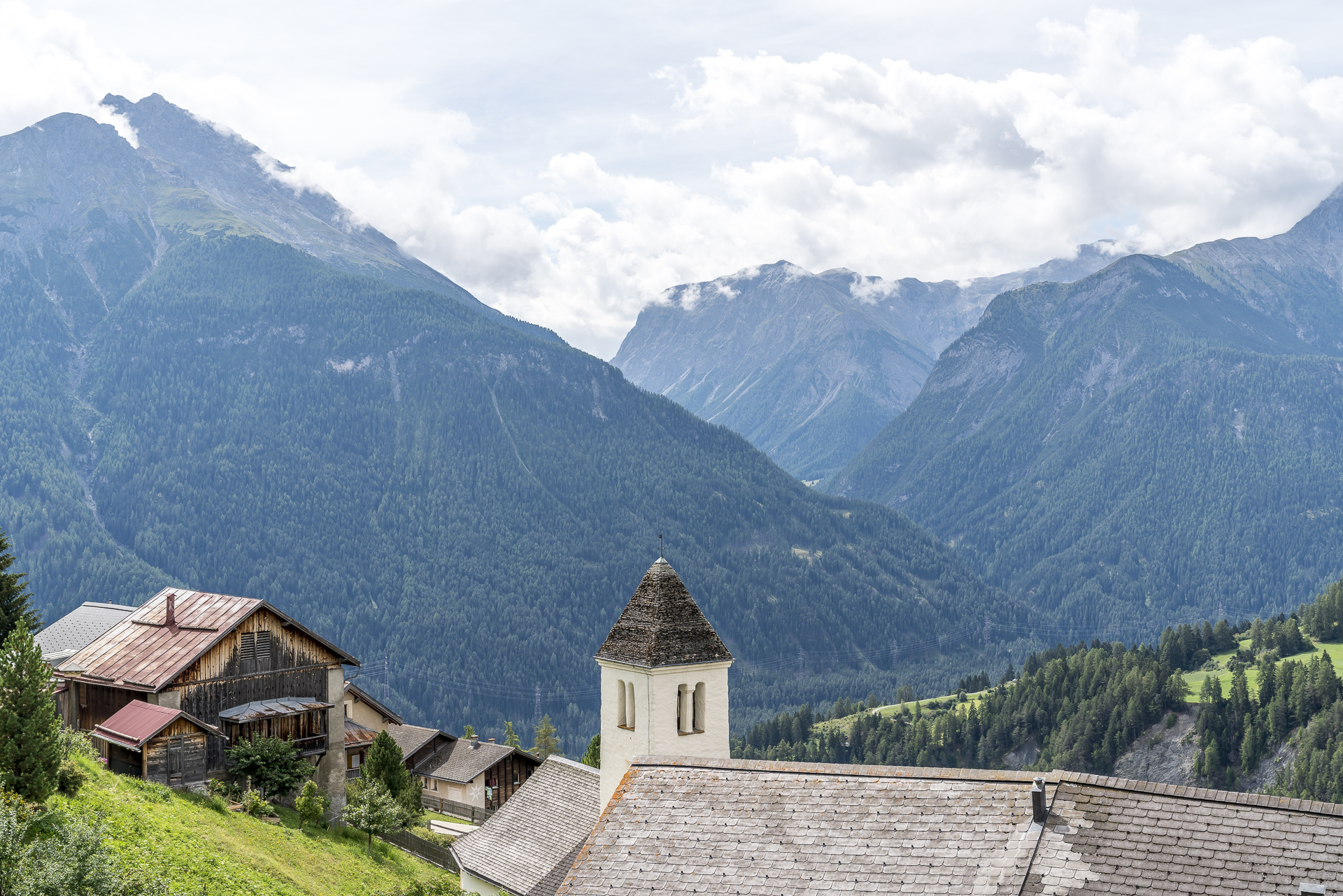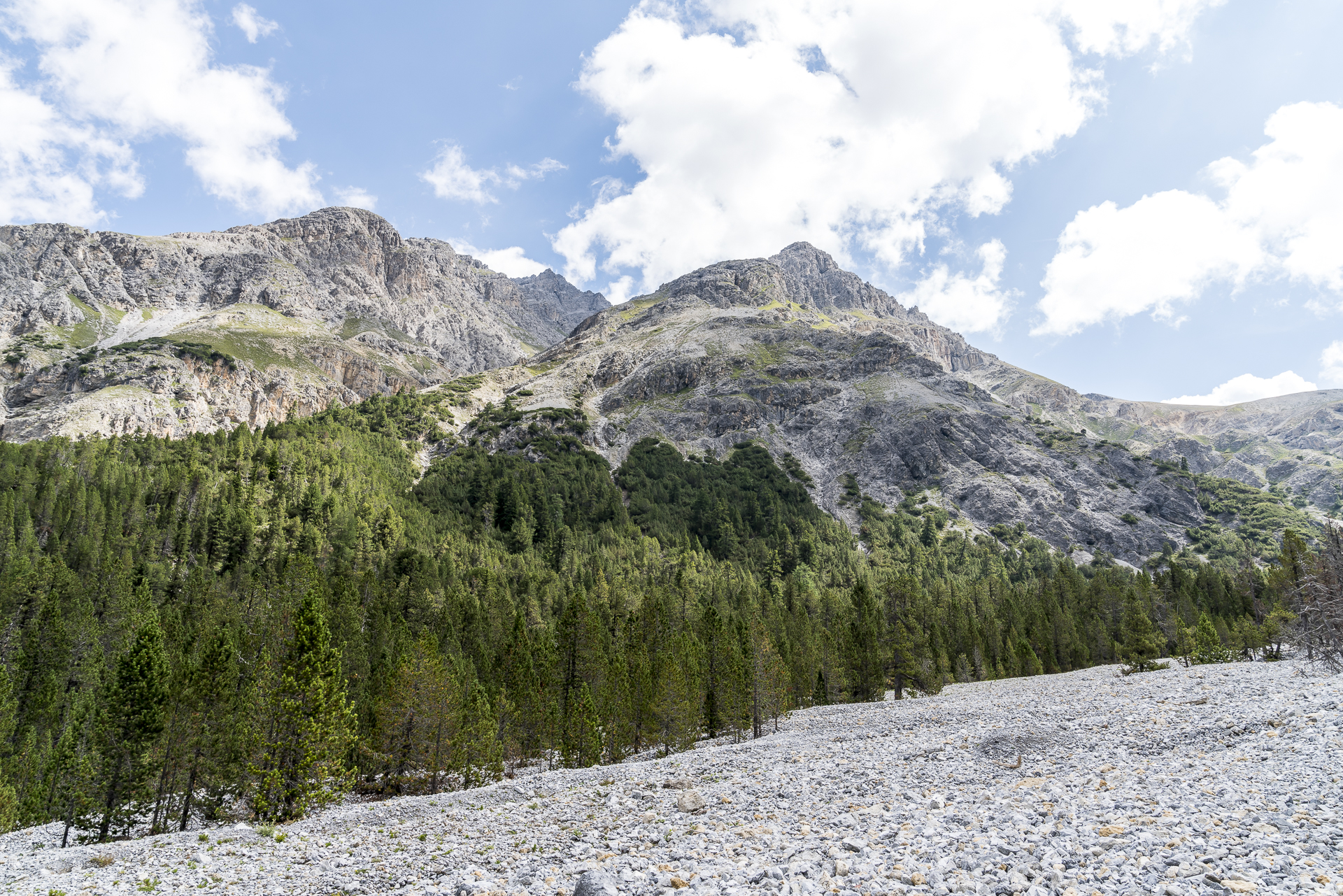
Lower Engadine hiking paradise – our active weekend around Scuol
Advertising – this article was created in cooperation with Engadin Scuol
There are regions to which I am always drawn back – one of them is the Lower Engadine. We have been guests in Ftan and Guarda several times in recent years, and two weeks ago I once again boarded the train in Zurich with the goal of “Scuol-Tarasp”. In contrast to my previous trips to the Lower Engadine, this time the Scuol-Tarasp train station was not only a transport hub with a post bus connection, but the final stop. After all, you can’t travel to the Lower Engadine four times and not stay once in the largest village in the valley.
3 days: 3 hikes
There is a good reason why I am travelling to the Lower Engadine for a long weekend for the fourth time; it is simply a wonderful hiking region and offers countless exciting tours for every fitness level. While we were already hiking on the Way of St. James from one beautiful mountain village to the next or wandering through pouring rain over the magical Macun plain, I have again picked out three completely different hikes for this weekend. In contrast to previous visits to this region, Peter also followed the stage directions for once.
Mineral Water Trail Scuol
While dark clouds dominated the sky on the north side of the Vereina tunnel on Friday morning, rays of sunshine await me on the south side. Lucky! My first hike starts right after I arrive. Together with Sabina Streiter, I set off on the mineral water trail. The numerous mineral springs that spring up in the area of Scuol and Tarasp are largely responsible for the development of tourism in the region. In the 14th century, the healing power of the local springs was mentioned for the first time. In the second half of the 19th century, spa tourism in the Lower Engadine reached its peak. Even though the same illustrious international crowd of guests no longer flocks to Scuol-Tarasp for week-long spa treatments, the mineral-rich springs have lost none of their fascination.
First of all, Sabina Streiter explains to me that many wells in Scuol are fed by two springs. While normal spring water flows from one tube, mineral water gushes out of the other tube – this is evident in the basin by the reddish and yellow limestone deposits.
“Are there any springs that dry up in such a dry summer?” I want to know from Sabina Streiter. The answer to this question fascinates me! For some springs in Scuol it takes five years for the water to come back to the surface, at the Tarasper springs it is even up to 25 years. The fissure water circulating underground is thus enriched with valuable minerals over a long period of time. The effects of this year’s dry summer weather in Scuol and Tarasp will therefore only become apparent in five and 25 years respectively. In 2008 – five years after the “hot summer” of 2003 – a few springs dried up in Scuol.
The Mineral Water Trail leads in two different routes (Blue Trail / Red Trail) from Sent via Scuol to Tarasp. If you want to visit all the accessible springs, you will need more than a day. Together with Sabina Streiter, I visit the Vi, Clozza and Sotsass springs, which are located near the village center of Scuol, and then look at the village fountains, where the sour mineral water gushes out. By the way, if you think that water tastes like “nothing”, you will be taught better by tasting the highly mineralized waters. I like the water of the Lischana spring best. The spring is located in a small house on the banks of the Inn and numerous people regularly fill glass bottles with the mineral-rich water here.
For me, the walk along the mineral water trail is the ideal start to our hiking weekend in Scuol. Not only did I get moving, but I also learned exciting facts about the region and the precious water along the way.
On the suspension bridge path through Val Sinestra
After a wonderfully quiet and cool night in a room scented with pine wood at the Hotel Engiadina, we start our day with a short walk to the fountain «Plaz», which is fed by the Sotsass spring. Here we fill our drinking bottles halfway with the mineral water and then dilute it with “normal” spring water. If you drink too much of the mineral water, you have to expect a sudden onset of digestion – not practical for a longer hike.
Afterwards we take the post bus to Val Sinestra. The stop at the former Kurhaus (which is now run as a hotel again) is only served three times a day. I am all the more astonished that we are the only ones in the Postbus. The Kurhaus Val Sinestra is an incredibly imposing building – and the location in the middle of this remote side valley, with nothing but fir trees all around, offers an impressive backdrop. We start our hike here along the Hangbrückenweg up the valley past the idyllic Hof Zuort (which I have already raved about here) to Griosch. The trail is congruent with the Engadine high-altitude trail “Via Engiadina”, which leads all the way to Vinadi. If you miss the post bus to Val Sinestra, you can also start the hike in Sent (about 6 kilometres longer).
While the section from the Kurhaus to Griosch leads through the densely wooded Val Sinestra, which is criss-crossed by deep gorges, the section from Vnà to Tschlin is dominated by panoramic views over cultivated alpine pastures to the rugged peaks on the opposite side of the valley. A varied and entertaining route along the sun-drenched southern slopes of the Lower Engadine.
Hiking facts: Via the Suspension Bridge Trail from the Kurhaus Val Sinestra to Tschlin
Length: 17.2 kilometres
Difference in altitude: 800 m ascent, 735 m descent
Hiking time: approx. 5 hours
Accessibility: 3 times a day post bus connection to Val Sinestra
Good to know: Instead of Tschlin, the tour can only be done
as far as Vnà
Outdoor wellness in Tschlin
After almost five hours of hiking, my stomach growls when I arrive in Chlin. My short research in advance has shown that the selection of pubs in Tschlin is not exactly productive – but that is not necessary at all! If you find the terrace of the Hotel Macun and order the “Marenda da Bun Tschlin“ there, you are doing everything right in my opinion. The Zvieriplättli served to us made it to the top of my personal (not systematically managed) Zvieriplättli ranking in no time at all. The balanced ratio of cheese and meat and, above all, the consistent regional reference are commendable.
However, the reason why we hiked all the way to Tschlin on this day is not the Zvieriplättli, but the project “Il Bügl Public”. We catch one of the six Saturdays of this summer, when the village fountain of Tschlin is transformed into a heated “outdoor swimming pool”. The initiator of the project is the artist Curdin Tones. A really funny idea and also a really charming implementation – including a herbal bath tub next to the fountain. And indeed: the Bügl Sura mutates into a meeting place between locals and foreigners on this afternoon.
Pure nature in Val Mingèr
The region around Scuol is not only known for its mineral springs and picturesque town centres, but is also the starting point for tours across the Swiss National Park. A spike of the National Park is located on the territory of the municipality of Scuol: the Val Mingèr. In October, when the larches glow, Val Mingèr offers one of the best starting points for observing red deer during the rut. On this hot August Sunday, the deer have probably retreated far into the cool thickets. We leave the post bus (filled to the last seat) in the direction of S-charl at the Val Mingèr stop and follow the narrow path through a wild and romantic forest uphill towards Alp Mingèr. I like the steadily gently ascending path very much and accordingly we quickly reach the highest point of the “Sur il Foss” tour. Here we leave the national park again and descend in Val Plavna in front of the imposing backdrop of Piz Plavna Dadaint.
The panorama that is offered to us up here is phenomenal! I had packed a small picnic for this tour as a precaution, as I assumed that there would be no places to stop for refreshments along the way. Fortunately, a sign at the top of the pass informs us that after 45 minutes the Hirtebeizli Alp Plavna follows. Elated, we hike down into the valley – this refreshment stop is immensely motivating. The shepherd’s pub is just as sympathetic as we imagined. A simple snack plate with products made directly on the alp and a refreshing homemade iced tea. Hallelujah! And funnily enough, we are the only guests on site on this Sunday afternoon. It doesn’t seem to have spread far yet how beautiful it is here in Val Plavna.
Just before we reach Tarasp, the trail passes a junction that leads to the Funtana da Suolper spring. Afterwards we can already see the striking Tarasp Castle in front of us. We use the time until the departure of the next post bus in the direction of Scuol-Tarasp for a detour to Lai da Tarasp. The silvery shimmering sphere in the middle of the lake is one of the installations by the Senter artist Not Vital, who has been the castlekeeper of Tarasp Castle since 2016. I postpone the visit to the other art installations until next time – so there is a good reason for a fifth trip to the Lower Engadine.
Hiking facts: from Val Mingèr to Tarasp
Length: 16.25 kilometers
Elevation gain: 725 m ascent, 975 m descent
Hiking time: just under 5 hours
Accessibility: by post bus from Scuol in the direction of S-charl, stop Val Mingèr
Practical tips for your hiking weekend around Scuol
- In the summer months (until mid-October) there is a guided hike along the mineral water trail on Tuesdays.
- We stayed at the recommended Hotel Engiadina. We were particularly impressed by the careful selection of local products at the breakfast buffet.
- From an overnight stay in the hotel, every guest receives the Engadin Scuol Mobil Card, which includes free travel on public transport and one ride per day on the Scuol-Motta Naluns gondola.
- Within walking distance of the Hotel Engiadina is the Bogn Engiadina mineral bath, where you can relax after a long day of hiking.
- Along the Via Engiadina, day hikes are possible (starting in Scuol) or multi-day hikes organized with luggage transport (in the section Zernez – Tschlin).
- From Val Mingèr, you can alternatively hike to the Ofen Pass (Il Fuorn) in about six hours.





































Leave a Reply